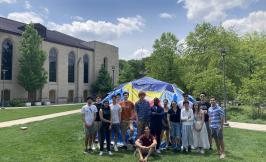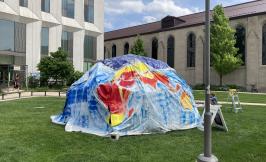How to Build a Memorial: The 1995 Chicago Heat Wave
Students in the course HIST/CHST 17706: How to Build a Memorial spent Spring Quarter learning about the disaster of the 1995 Chicago Heat Wave. Impacting communities among which our University of Chicago Campus resides, this horrific heat wave produced 739 heat related deaths in the course of five days in July of 1995. In addition to learning about this disaster, this course gave students the unique opportunity to develop and hand-create a 1995 Heat wave memorial for the University of Chicago campus. The students worked hard to understand what goes into the process of building a memorial by investigating many memorials throughout Chicago. The installation stood on the North campus/Smart/Crown quad, and offered students, faculty, and community members alike an opportunity to explore the effects of the heatwave with an interactive dome that showcased personal survivor stories and statistics.
I asked Ellie Kalil-Felbinger, a student in the course who coordinated communications, several questions about the project. Below are her responses.
What led the class to choose to memorialize the disastrous 1995 Chicago heat wave?
The class chose to memorialize the disastrous 1995 Chicago heat wave because of its significance in the city’s history. The heatwave revealed critical issues such as urban vulnerability, social inequality, and the impacts of climate change. Over 700 died, disproportionately affecting elderly and low-income communities. This tragic event underscored the need for better urban planning, emergency response systems, and social services to protect vulnerable populations in the city of Chicago. Memorializing the heat wave serves as a powerful reminder of these issues and a call to action to prevent similar, and likely, future tragedies.
How did the group develop the memorial? Why did you choose a dome?
The group developed the memorial through collaborative discussions, research and design sessions, and visits to other Chicago memorials. We chose a dome as the central feature of the memorial for several reasons. Firstly, a dome symbolizes protection and shelter, reflecting the need for safeguarding vulnerable communities during extreme weather events such as the heatwave. Secondly, the dome’s encompassing shape created an intimate space for reflection and education. It also represented the interconnectedness of the issues highlighted by the heat wave, such as urban planning, social justice, and climate change. Additionally, the dome entrapped heat to symbolize the oppressive conditions many experienced in the 1995 heat wave. By creating an environment that mirrors the intense heat felt during that summer, visitors could gain a visceral understanding of the possible physical discomfort and danger faced by the residents of Chicago during the disaster. This experiential aspect of the memorial served to heighten empathy and awareness, conveying the message that the heat wave was not just a statistic but a truly devastating human experience. The trapped heat within the dome also underscored the urgency of addressing climate change and its impacts on urban environments, prompting visitors to consider broader implications of other extreme weather events on vulnerable populations. The outer part of the dome was painted with a map of global heat risk to gesture towards global warming and climate change, while the inside highlighted the local Chicago aspect.
What were some of the sites you visited and how did they influence this project?
We took a class visit to the Climate Action Museum that contributed to the forewarning stance we tried to embody in our memorial. We wanted our memorial to not only honor the victims of the 1995 Chicago heat wave but also serve as a powerful warning about the future impacts of climate change, and the devastating weather events associated. The exhibits at the Climate Action Museum emphasized proactive measures and education to prevent future disasters. This visit reinforced our commitment to creating a symbolic memorial used to educate the public about the ongoing risks posed by climate change and call to action the immediate need to protect vulnerable communities.
Is there a reason you chose the North Campus quad as the site for the installation?
The decision to install the memorial at the North Campus Quad at UChicago was deliberate and thoughtfully chosen. This location is central to different communities, accessible, and frequented by students, faculty, and visitors, ensuring high visibility and engagement. The Quad's open space allowed for the installation of a large structure like the dome, providing ample room for visitors to gather and reflect. Additionally, the North Campus Quad is a place where academic and social conversations often intersect, making it the perfect setting for a memorial that aims to educate and inspire action on urgent social and environmental issues.
What do you hope viewers who visited the exhibit will have learned and how do you hope they’ll make use of their newfound knowledge?
We hope that viewers who visited the exhibit gained a deeper understanding of the 1995 Chicago Heat Wave and some of its underlying causes including urban vulnerability, social inequality, and worsening effects of climate change. The memorial was designed to educate visitors on the historical context of the event, the socio-economic factors that exacerbated its impact, and the lessons learned in a reflection of its aftermath. We aimed to inspire visitors to think critically about how these issues persist today and encourage them to advocate for better urban planning, stronger social services, and proactive measures from the government to combat climate change. Ultimately, we hope our memorial fostered a sense of community responsibility and motivates viewers to take action as they can in their own lives and communities to build a more resilient and equitable future.
 THE UNIVERSITY OF CHICAGO
THE UNIVERSITY OF CHICAGO





